La Trobe University PHE5PAP Public Health in Australia Report
VerifiedAdded on 2023/01/17
|7
|1595
|89
Report
AI Summary
This report, prepared for the Minister of Health, addresses the critical public health issue of mental illness in Australia. It begins by defining public health and highlighting the prevalence of mental health conditions among various age groups, including young people and the elderly. The report details the nature of the health problem, emphasizing its broad impact on individuals, families, and society, including unemployment and homelessness. It identifies the affected population, emphasizing the high percentage of Australians experiencing mental illness, and examines the magnitude of the problem across different demographics, such as veterans, LGBTQ+ individuals, and women. Furthermore, it explores the distal and proximal determinants of mental illness, connecting it to chronic diseases and lifestyle factors. The report then presents the core features of the targeted population, including substance use and social disparities. Finally, it argues for the necessity of government intervention, emphasizing the need to address social determinants of health and strengthen the healthcare system through policy and promotion.
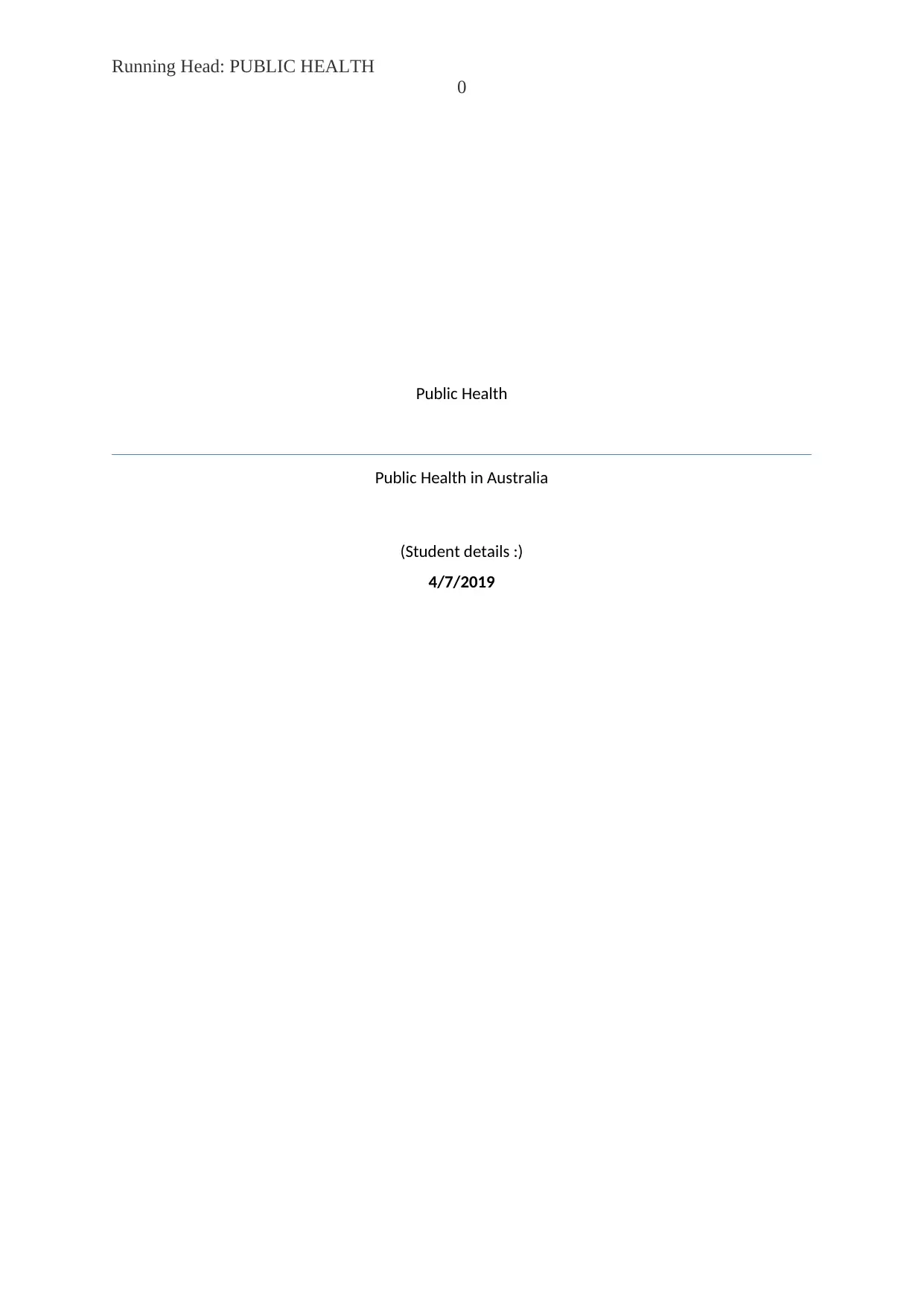
Running Head: PUBLIC HEALTH
0
Public Health
Public Health in Australia
(Student details :)
4/7/2019
0
Public Health
Public Health in Australia
(Student details :)
4/7/2019
Paraphrase This Document
Need a fresh take? Get an instant paraphrase of this document with our AI Paraphraser
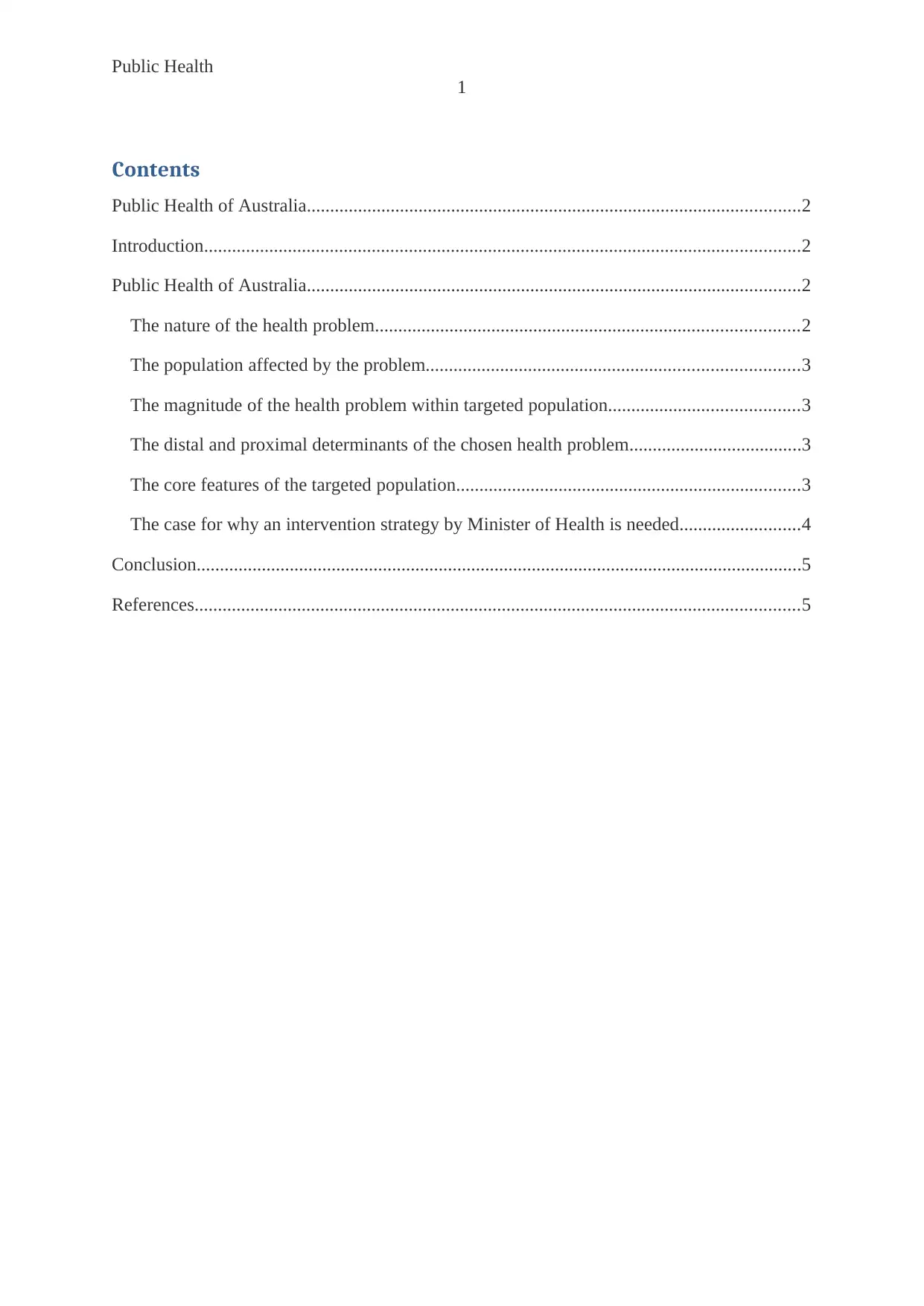
Public Health
1
Contents
Public Health of Australia..........................................................................................................2
Introduction................................................................................................................................2
Public Health of Australia..........................................................................................................2
The nature of the health problem...........................................................................................2
The population affected by the problem................................................................................3
The magnitude of the health problem within targeted population.........................................3
The distal and proximal determinants of the chosen health problem.....................................3
The core features of the targeted population..........................................................................3
The case for why an intervention strategy by Minister of Health is needed..........................4
Conclusion..................................................................................................................................5
References..................................................................................................................................5
1
Contents
Public Health of Australia..........................................................................................................2
Introduction................................................................................................................................2
Public Health of Australia..........................................................................................................2
The nature of the health problem...........................................................................................2
The population affected by the problem................................................................................3
The magnitude of the health problem within targeted population.........................................3
The distal and proximal determinants of the chosen health problem.....................................3
The core features of the targeted population..........................................................................3
The case for why an intervention strategy by Minister of Health is needed..........................4
Conclusion..................................................................................................................................5
References..................................................................................................................................5
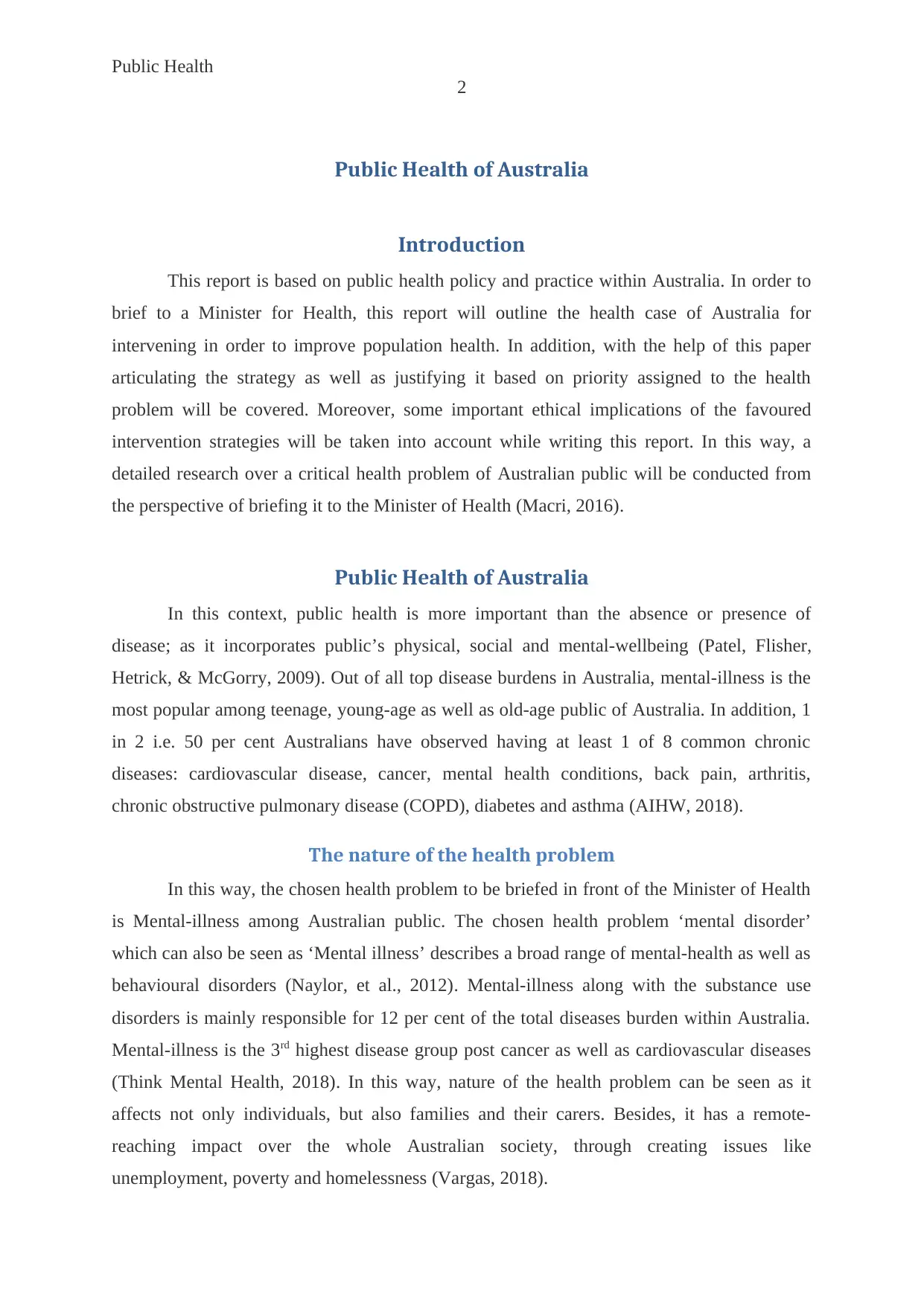
Public Health
2
Public Health of Australia
Introduction
This report is based on public health policy and practice within Australia. In order to
brief to a Minister for Health, this report will outline the health case of Australia for
intervening in order to improve population health. In addition, with the help of this paper
articulating the strategy as well as justifying it based on priority assigned to the health
problem will be covered. Moreover, some important ethical implications of the favoured
intervention strategies will be taken into account while writing this report. In this way, a
detailed research over a critical health problem of Australian public will be conducted from
the perspective of briefing it to the Minister of Health (Macri, 2016).
Public Health of Australia
In this context, public health is more important than the absence or presence of
disease; as it incorporates public’s physical, social and mental-wellbeing (Patel, Flisher,
Hetrick, & McGorry, 2009). Out of all top disease burdens in Australia, mental-illness is the
most popular among teenage, young-age as well as old-age public of Australia. In addition, 1
in 2 i.e. 50 per cent Australians have observed having at least 1 of 8 common chronic
diseases: cardiovascular disease, cancer, mental health conditions, back pain, arthritis,
chronic obstructive pulmonary disease (COPD), diabetes and asthma (AIHW, 2018).
The nature of the health problem
In this way, the chosen health problem to be briefed in front of the Minister of Health
is Mental-illness among Australian public. The chosen health problem ‘mental disorder’
which can also be seen as ‘Mental illness’ describes a broad range of mental-health as well as
behavioural disorders (Naylor, et al., 2012). Mental-illness along with the substance use
disorders is mainly responsible for 12 per cent of the total diseases burden within Australia.
Mental-illness is the 3rd highest disease group post cancer as well as cardiovascular diseases
(Think Mental Health, 2018). In this way, nature of the health problem can be seen as it
affects not only individuals, but also families and their carers. Besides, it has a remote-
reaching impact over the whole Australian society, through creating issues like
unemployment, poverty and homelessness (Vargas, 2018).
2
Public Health of Australia
Introduction
This report is based on public health policy and practice within Australia. In order to
brief to a Minister for Health, this report will outline the health case of Australia for
intervening in order to improve population health. In addition, with the help of this paper
articulating the strategy as well as justifying it based on priority assigned to the health
problem will be covered. Moreover, some important ethical implications of the favoured
intervention strategies will be taken into account while writing this report. In this way, a
detailed research over a critical health problem of Australian public will be conducted from
the perspective of briefing it to the Minister of Health (Macri, 2016).
Public Health of Australia
In this context, public health is more important than the absence or presence of
disease; as it incorporates public’s physical, social and mental-wellbeing (Patel, Flisher,
Hetrick, & McGorry, 2009). Out of all top disease burdens in Australia, mental-illness is the
most popular among teenage, young-age as well as old-age public of Australia. In addition, 1
in 2 i.e. 50 per cent Australians have observed having at least 1 of 8 common chronic
diseases: cardiovascular disease, cancer, mental health conditions, back pain, arthritis,
chronic obstructive pulmonary disease (COPD), diabetes and asthma (AIHW, 2018).
The nature of the health problem
In this way, the chosen health problem to be briefed in front of the Minister of Health
is Mental-illness among Australian public. The chosen health problem ‘mental disorder’
which can also be seen as ‘Mental illness’ describes a broad range of mental-health as well as
behavioural disorders (Naylor, et al., 2012). Mental-illness along with the substance use
disorders is mainly responsible for 12 per cent of the total diseases burden within Australia.
Mental-illness is the 3rd highest disease group post cancer as well as cardiovascular diseases
(Think Mental Health, 2018). In this way, nature of the health problem can be seen as it
affects not only individuals, but also families and their carers. Besides, it has a remote-
reaching impact over the whole Australian society, through creating issues like
unemployment, poverty and homelessness (Vargas, 2018).
⊘ This is a preview!⊘
Do you want full access?
Subscribe today to unlock all pages.

Trusted by 1+ million students worldwide
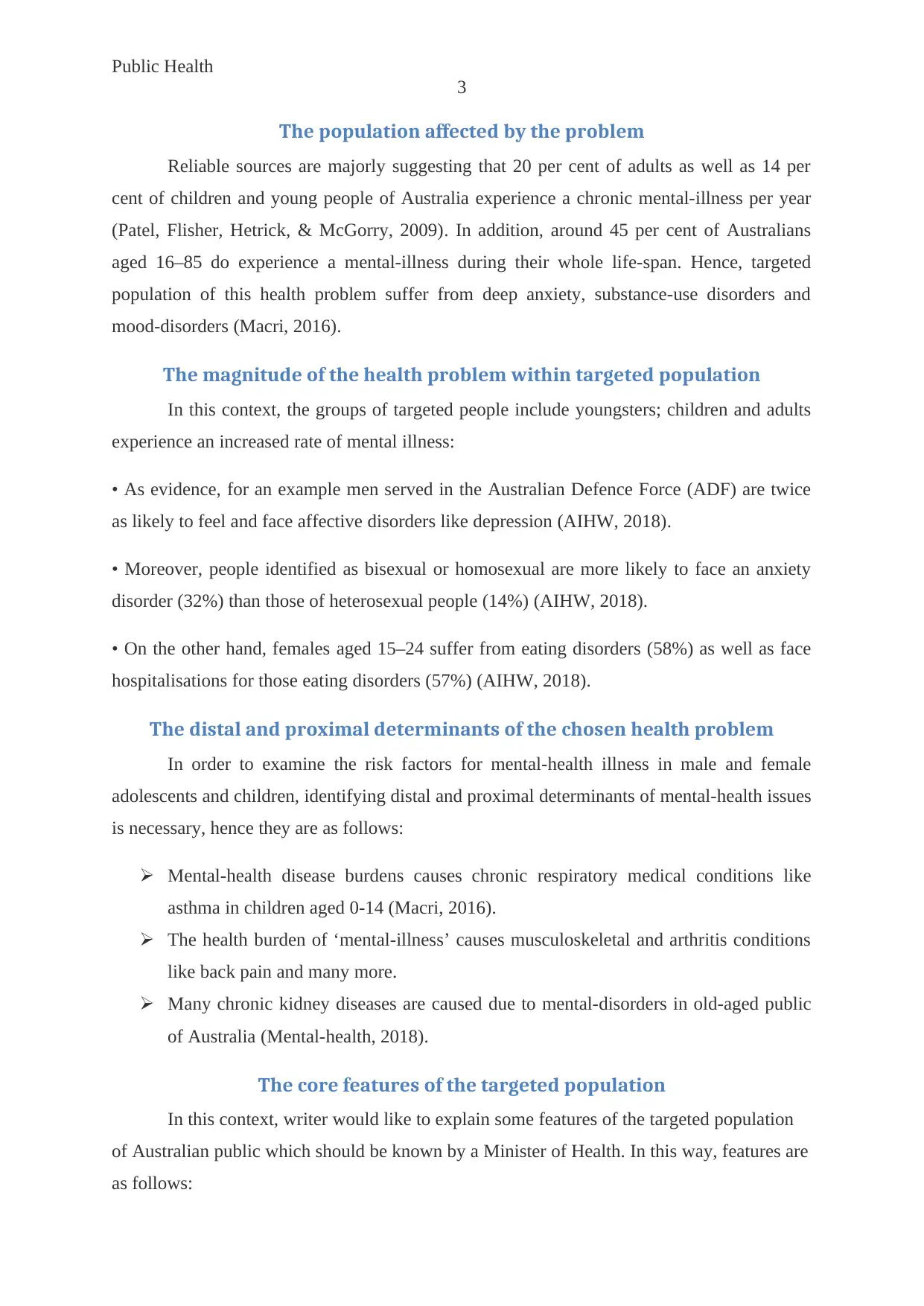
Public Health
3
The population affected by the problem
Reliable sources are majorly suggesting that 20 per cent of adults as well as 14 per
cent of children and young people of Australia experience a chronic mental-illness per year
(Patel, Flisher, Hetrick, & McGorry, 2009). In addition, around 45 per cent of Australians
aged 16–85 do experience a mental-illness during their whole life-span. Hence, targeted
population of this health problem suffer from deep anxiety, substance-use disorders and
mood-disorders (Macri, 2016).
The magnitude of the health problem within targeted population
In this context, the groups of targeted people include youngsters; children and adults
experience an increased rate of mental illness:
• As evidence, for an example men served in the Australian Defence Force (ADF) are twice
as likely to feel and face affective disorders like depression (AIHW, 2018).
• Moreover, people identified as bisexual or homosexual are more likely to face an anxiety
disorder (32%) than those of heterosexual people (14%) (AIHW, 2018).
• On the other hand, females aged 15–24 suffer from eating disorders (58%) as well as face
hospitalisations for those eating disorders (57%) (AIHW, 2018).
The distal and proximal determinants of the chosen health problem
In order to examine the risk factors for mental-health illness in male and female
adolescents and children, identifying distal and proximal determinants of mental-health issues
is necessary, hence they are as follows:
Mental-health disease burdens causes chronic respiratory medical conditions like
asthma in children aged 0-14 (Macri, 2016).
The health burden of ‘mental-illness’ causes musculoskeletal and arthritis conditions
like back pain and many more.
Many chronic kidney diseases are caused due to mental-disorders in old-aged public
of Australia (Mental-health, 2018).
The core features of the targeted population
In this context, writer would like to explain some features of the targeted population
of Australian public which should be known by a Minister of Health. In this way, features are
as follows:
3
The population affected by the problem
Reliable sources are majorly suggesting that 20 per cent of adults as well as 14 per
cent of children and young people of Australia experience a chronic mental-illness per year
(Patel, Flisher, Hetrick, & McGorry, 2009). In addition, around 45 per cent of Australians
aged 16–85 do experience a mental-illness during their whole life-span. Hence, targeted
population of this health problem suffer from deep anxiety, substance-use disorders and
mood-disorders (Macri, 2016).
The magnitude of the health problem within targeted population
In this context, the groups of targeted people include youngsters; children and adults
experience an increased rate of mental illness:
• As evidence, for an example men served in the Australian Defence Force (ADF) are twice
as likely to feel and face affective disorders like depression (AIHW, 2018).
• Moreover, people identified as bisexual or homosexual are more likely to face an anxiety
disorder (32%) than those of heterosexual people (14%) (AIHW, 2018).
• On the other hand, females aged 15–24 suffer from eating disorders (58%) as well as face
hospitalisations for those eating disorders (57%) (AIHW, 2018).
The distal and proximal determinants of the chosen health problem
In order to examine the risk factors for mental-health illness in male and female
adolescents and children, identifying distal and proximal determinants of mental-health issues
is necessary, hence they are as follows:
Mental-health disease burdens causes chronic respiratory medical conditions like
asthma in children aged 0-14 (Macri, 2016).
The health burden of ‘mental-illness’ causes musculoskeletal and arthritis conditions
like back pain and many more.
Many chronic kidney diseases are caused due to mental-disorders in old-aged public
of Australia (Mental-health, 2018).
The core features of the targeted population
In this context, writer would like to explain some features of the targeted population
of Australian public which should be known by a Minister of Health. In this way, features are
as follows:
Paraphrase This Document
Need a fresh take? Get an instant paraphrase of this document with our AI Paraphraser
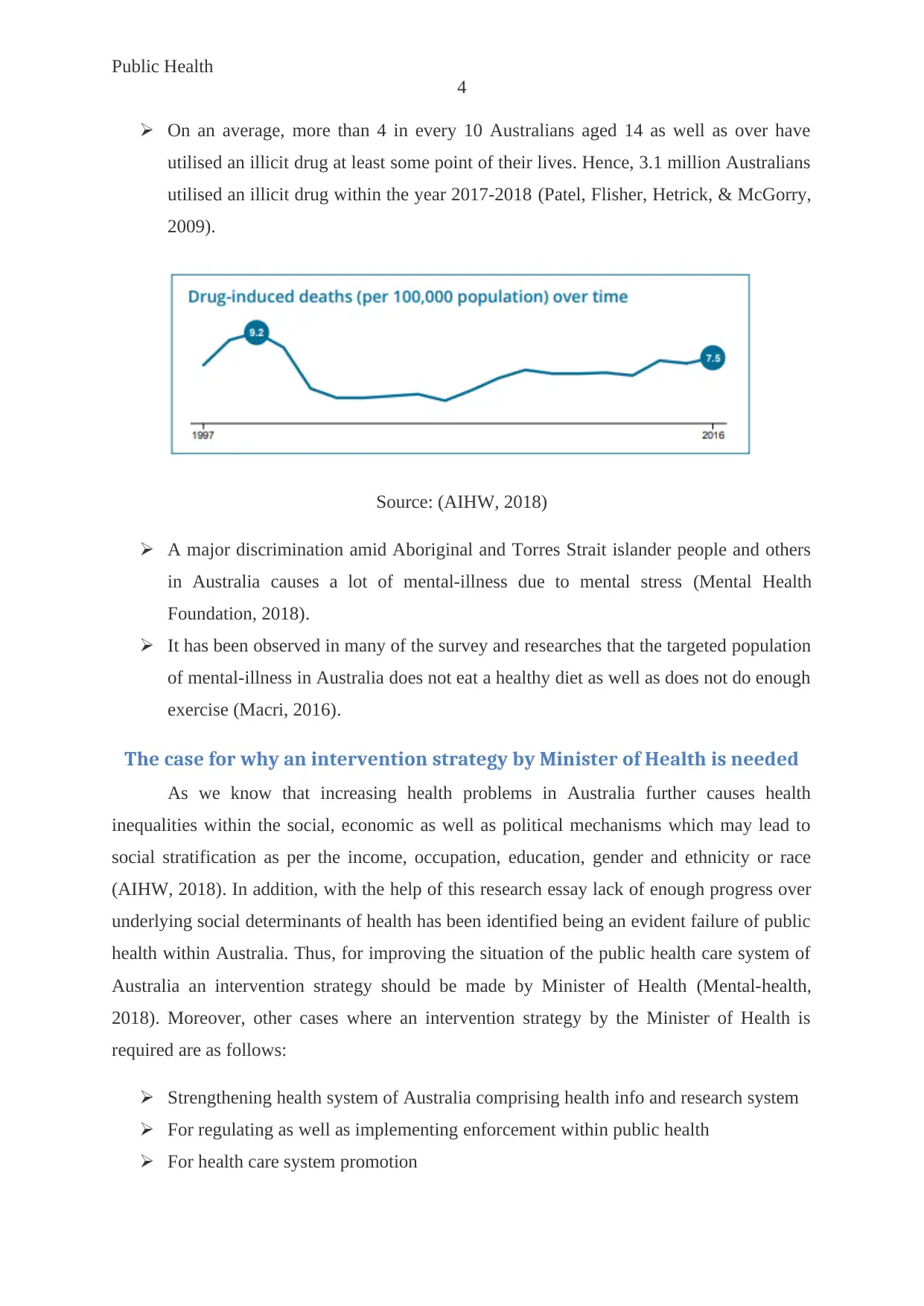
Public Health
4
On an average, more than 4 in every 10 Australians aged 14 as well as over have
utilised an illicit drug at least some point of their lives. Hence, 3.1 million Australians
utilised an illicit drug within the year 2017-2018 (Patel, Flisher, Hetrick, & McGorry,
2009).
Source: (AIHW, 2018)
A major discrimination amid Aboriginal and Torres Strait islander people and others
in Australia causes a lot of mental-illness due to mental stress (Mental Health
Foundation, 2018).
It has been observed in many of the survey and researches that the targeted population
of mental-illness in Australia does not eat a healthy diet as well as does not do enough
exercise (Macri, 2016).
The case for why an intervention strategy by Minister of Health is needed
As we know that increasing health problems in Australia further causes health
inequalities within the social, economic as well as political mechanisms which may lead to
social stratification as per the income, occupation, education, gender and ethnicity or race
(AIHW, 2018). In addition, with the help of this research essay lack of enough progress over
underlying social determinants of health has been identified being an evident failure of public
health within Australia. Thus, for improving the situation of the public health care system of
Australia an intervention strategy should be made by Minister of Health (Mental-health,
2018). Moreover, other cases where an intervention strategy by the Minister of Health is
required are as follows:
Strengthening health system of Australia comprising health info and research system
For regulating as well as implementing enforcement within public health
For health care system promotion
4
On an average, more than 4 in every 10 Australians aged 14 as well as over have
utilised an illicit drug at least some point of their lives. Hence, 3.1 million Australians
utilised an illicit drug within the year 2017-2018 (Patel, Flisher, Hetrick, & McGorry,
2009).
Source: (AIHW, 2018)
A major discrimination amid Aboriginal and Torres Strait islander people and others
in Australia causes a lot of mental-illness due to mental stress (Mental Health
Foundation, 2018).
It has been observed in many of the survey and researches that the targeted population
of mental-illness in Australia does not eat a healthy diet as well as does not do enough
exercise (Macri, 2016).
The case for why an intervention strategy by Minister of Health is needed
As we know that increasing health problems in Australia further causes health
inequalities within the social, economic as well as political mechanisms which may lead to
social stratification as per the income, occupation, education, gender and ethnicity or race
(AIHW, 2018). In addition, with the help of this research essay lack of enough progress over
underlying social determinants of health has been identified being an evident failure of public
health within Australia. Thus, for improving the situation of the public health care system of
Australia an intervention strategy should be made by Minister of Health (Mental-health,
2018). Moreover, other cases where an intervention strategy by the Minister of Health is
required are as follows:
Strengthening health system of Australia comprising health info and research system
For regulating as well as implementing enforcement within public health
For health care system promotion
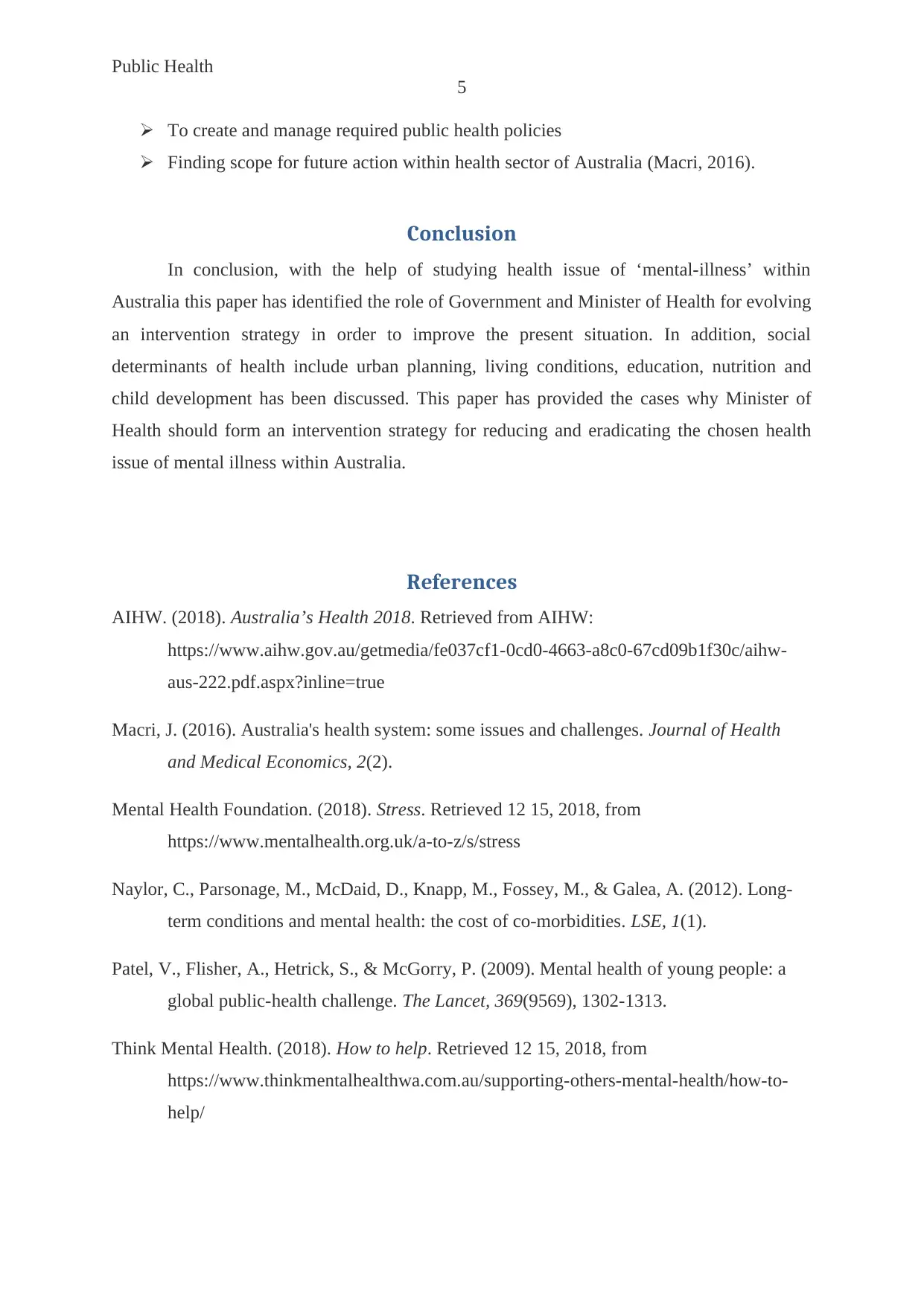
Public Health
5
To create and manage required public health policies
Finding scope for future action within health sector of Australia (Macri, 2016).
Conclusion
In conclusion, with the help of studying health issue of ‘mental-illness’ within
Australia this paper has identified the role of Government and Minister of Health for evolving
an intervention strategy in order to improve the present situation. In addition, social
determinants of health include urban planning, living conditions, education, nutrition and
child development has been discussed. This paper has provided the cases why Minister of
Health should form an intervention strategy for reducing and eradicating the chosen health
issue of mental illness within Australia.
References
AIHW. (2018). Australia’s Health 2018. Retrieved from AIHW:
https://www.aihw.gov.au/getmedia/fe037cf1-0cd0-4663-a8c0-67cd09b1f30c/aihw-
aus-222.pdf.aspx?inline=true
Macri, J. (2016). Australia's health system: some issues and challenges. Journal of Health
and Medical Economics, 2(2).
Mental Health Foundation. (2018). Stress. Retrieved 12 15, 2018, from
https://www.mentalhealth.org.uk/a-to-z/s/stress
Naylor, C., Parsonage, M., McDaid, D., Knapp, M., Fossey, M., & Galea, A. (2012). Long-
term conditions and mental health: the cost of co-morbidities. LSE, 1(1).
Patel, V., Flisher, A., Hetrick, S., & McGorry, P. (2009). Mental health of young people: a
global public-health challenge. The Lancet, 369(9569), 1302-1313.
Think Mental Health. (2018). How to help. Retrieved 12 15, 2018, from
https://www.thinkmentalhealthwa.com.au/supporting-others-mental-health/how-to-
help/
5
To create and manage required public health policies
Finding scope for future action within health sector of Australia (Macri, 2016).
Conclusion
In conclusion, with the help of studying health issue of ‘mental-illness’ within
Australia this paper has identified the role of Government and Minister of Health for evolving
an intervention strategy in order to improve the present situation. In addition, social
determinants of health include urban planning, living conditions, education, nutrition and
child development has been discussed. This paper has provided the cases why Minister of
Health should form an intervention strategy for reducing and eradicating the chosen health
issue of mental illness within Australia.
References
AIHW. (2018). Australia’s Health 2018. Retrieved from AIHW:
https://www.aihw.gov.au/getmedia/fe037cf1-0cd0-4663-a8c0-67cd09b1f30c/aihw-
aus-222.pdf.aspx?inline=true
Macri, J. (2016). Australia's health system: some issues and challenges. Journal of Health
and Medical Economics, 2(2).
Mental Health Foundation. (2018). Stress. Retrieved 12 15, 2018, from
https://www.mentalhealth.org.uk/a-to-z/s/stress
Naylor, C., Parsonage, M., McDaid, D., Knapp, M., Fossey, M., & Galea, A. (2012). Long-
term conditions and mental health: the cost of co-morbidities. LSE, 1(1).
Patel, V., Flisher, A., Hetrick, S., & McGorry, P. (2009). Mental health of young people: a
global public-health challenge. The Lancet, 369(9569), 1302-1313.
Think Mental Health. (2018). How to help. Retrieved 12 15, 2018, from
https://www.thinkmentalhealthwa.com.au/supporting-others-mental-health/how-to-
help/
⊘ This is a preview!⊘
Do you want full access?
Subscribe today to unlock all pages.

Trusted by 1+ million students worldwide

Public Health
6
Think Mental Health. (2018). How to start the conversation. Retrieved 12 15, 2018, from
https://www.thinkmentalhealthwa.com.au/supporting-others-mental-health/how-to-
help/how-to-start-the-conversation/
Vargas, S. (2018). ‘It’s not an easy conversation’: Mental health in the workplace. Retrieved
12 15, 2018, from https://www.safetyandhealthmagazine.com/articles/17489-its-not-
an-easy-conversation-mental-health-in-the-workplace
6
Think Mental Health. (2018). How to start the conversation. Retrieved 12 15, 2018, from
https://www.thinkmentalhealthwa.com.au/supporting-others-mental-health/how-to-
help/how-to-start-the-conversation/
Vargas, S. (2018). ‘It’s not an easy conversation’: Mental health in the workplace. Retrieved
12 15, 2018, from https://www.safetyandhealthmagazine.com/articles/17489-its-not-
an-easy-conversation-mental-health-in-the-workplace
1 out of 7
Related Documents
Your All-in-One AI-Powered Toolkit for Academic Success.
+13062052269
info@desklib.com
Available 24*7 on WhatsApp / Email
![[object Object]](/_next/static/media/star-bottom.7253800d.svg)
Unlock your academic potential
Copyright © 2020–2025 A2Z Services. All Rights Reserved. Developed and managed by ZUCOL.





